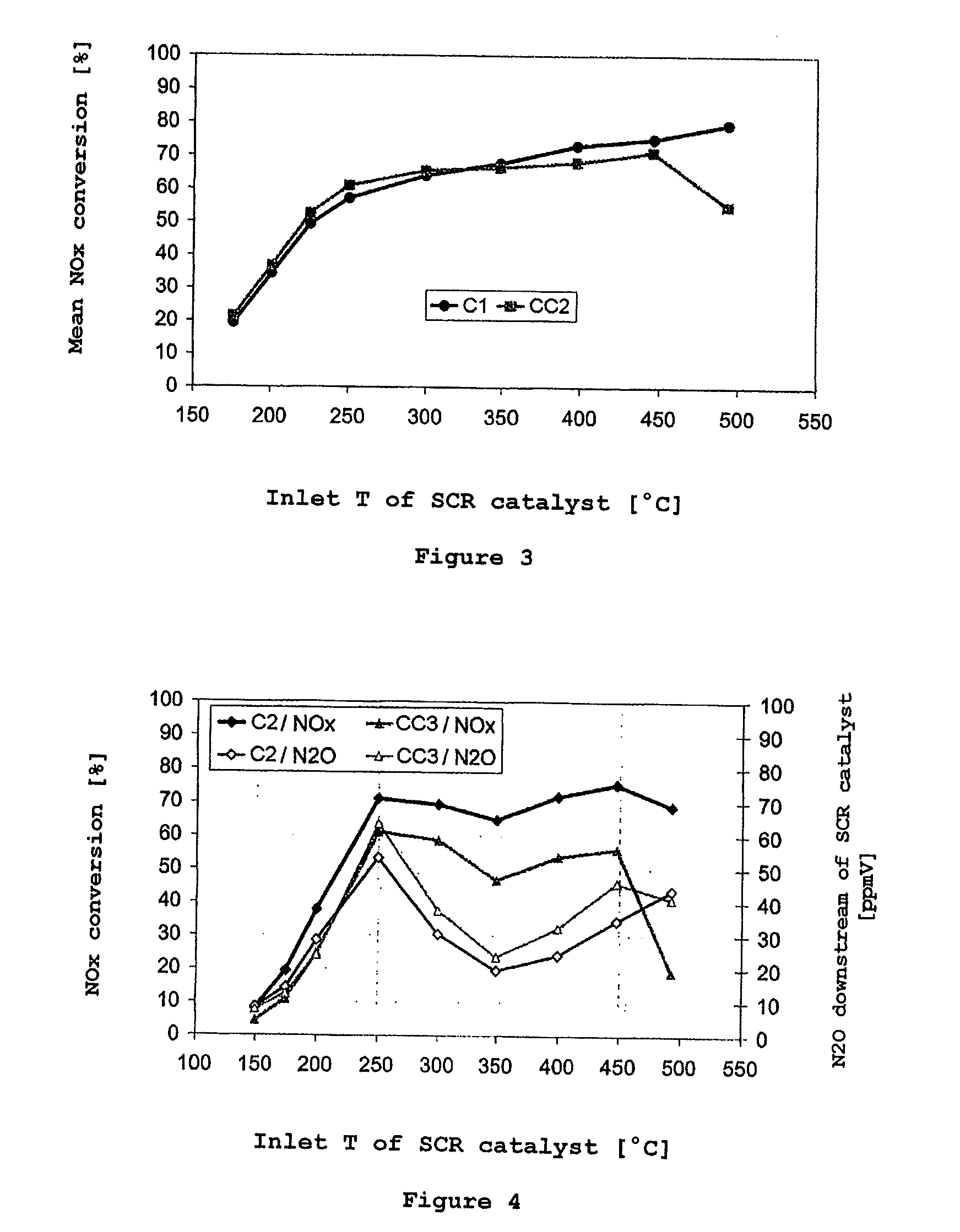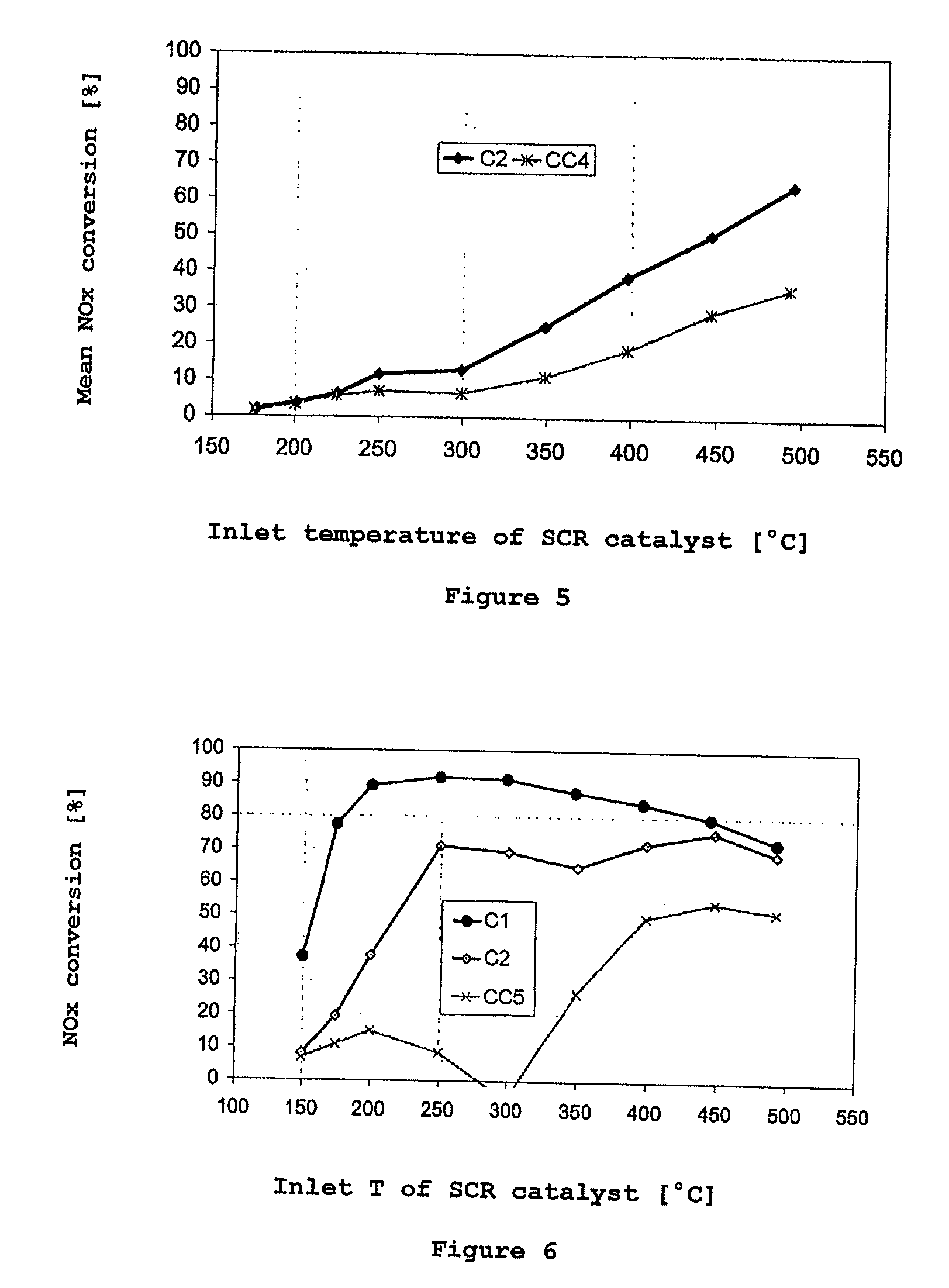Selective catalytic reduction of nitrogen oxides in the exhaust gas of diesel engines
a technology of nitrogen oxide and catalytic reduction, which is applied in the direction of metal/metal-oxide/metal-hydroxide catalyst, inorganic chemistry, phosphorus compounds, etc., can solve the problems of suitability of these catalysts and overoxidation of ammonia, and achieve excellent selectivity for nitrogen and improve conversion activity.
- Summary
- Abstract
- Description
- Claims
- Application Information
AI Technical Summary
Benefits of technology
Problems solved by technology
Method used
Image
Examples
example 1
[0061]According to the procedure outlined in comparative example 2, an inventive catalyst C1 was produced, the catalytically active composition of which had the following composition:[0062]96 g / l of SAPO-34 exchanged with 3% by weight of Cu[0063]48 g / l of homogeneous cerium-zirconium mixed oxide composed of 86% by weight of CeO2, 10% by weight of ZrO2 and 5% by weight of La2O3 [0064]16 g / l of aluminum oxide containing 4% by weight of La2O3 [0065]16 g / l of SiO2 from commercially available silica sol as a binder
[0066]The conversion behavior of the catalysts CC1 and C1 in the ammonia SCR reaction was examined after aging in a steady-state test and under dynamic conditions. FIG. 2 shows the results of the steady-state test. Above 350° C., the inventive catalyst C1 shows significant conversion advantages over the prior art catalyst CC2 which contains only the copper-exchanged zeolite-like compound SAPO-34. Surprisingly, the addition of the homogeneous cerium-zirconium mixed oxide leads, ...
example 2
[0073]A further inventive catalyst C2 was produced with a catalytically active coating of the following composition:[0074]96 g / l of β-zeolite exchanged with 5% by weight of Cu;[0075]48 g / l of homogeneous cerium-zirconium mixed oxide composed of 86% by weight of CeO2, 10% by weight of ZrO2 and 5% by weight of La2O3 [0076]16 g / l of aluminum oxide containing 4% by weight of La2O3 [0077]16 g / l of SiO2 from commercially available silica sol as a binder
[0078]The catalysts CC3 and C2 were subjected to the steady-state test after synthetic aging. FIG. 4 shows the result. The improvement in the nitrogen oxide conversion achieved by the blending with the cerium-zirconium oxide under steady-state conditions has an even clearer effect on a commercial Cu-exchanged β-zeolite SCR catalyst after aging than on the SAPO-34-based catalyst (CC2 / / C1). More particularly, the inventive catalyst C2, even from 200° C., exhibits distinct improvements in the NOx conversion behavior. The effect here is thus no...
PUM
| Property | Measurement | Unit |
|---|---|---|
| mean pore size | aaaaa | aaaaa |
| specific surface area | aaaaa | aaaaa |
| temperatures | aaaaa | aaaaa |
Abstract
Description
Claims
Application Information
 Login to View More
Login to View More - R&D
- Intellectual Property
- Life Sciences
- Materials
- Tech Scout
- Unparalleled Data Quality
- Higher Quality Content
- 60% Fewer Hallucinations
Browse by: Latest US Patents, China's latest patents, Technical Efficacy Thesaurus, Application Domain, Technology Topic, Popular Technical Reports.
© 2025 PatSnap. All rights reserved.Legal|Privacy policy|Modern Slavery Act Transparency Statement|Sitemap|About US| Contact US: help@patsnap.com



